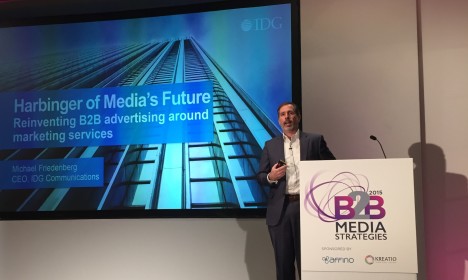Deep or wide? The existential question for business media
 B2B publishers face an imminent choice, argues Mumbrella’s Tim Burrowes. Should they chase a programmatic strategy, or should they double down on the width of their offering?
B2B publishers face an imminent choice, argues Mumbrella’s Tim Burrowes. Should they chase a programmatic strategy, or should they double down on the width of their offering?
I wonder if fans of independent publishing will look back upon the last decade as the final golden age of independent media.
After two days hearing from some of the biggest players in B2B, I now think that’s at least a possibility.
Last week saw the first B2B Media Strategies conference in London. It featured executives from many of the world’s biggest business publishers sharing their own lessons and strategies. And while they didn’t supply all the answers (these type of conferences never do), they certainly refocused the questions.
One of the most compelling presentations of the event came from Michael Friedenberg, CEO of the US-based IDG Communications (the people behind the likes of CIO and PC World).
The picture he drew was unlike your typical B2B publishing company.
The future (and near present) in IDGland is entirely programmatic.
The key to success in that environment is being able to generate comprehensive first person data about who your audience is, and the types of decisions they are making, then sell access to those people to advertisers at the key moment.
And to go a step further – by selling access to that audience not just on your own sites, but across the web.
This means being in the arbitrage business – buying impressions at a CPM of $2 and selling them on at $25 or more. Friedenberg revealed that by setting up its own trading desk, this has given IDG access to 1.2bn impressions per month.
It’s a daunting prospect for your average B2B publisher, of whom a not-insignificant proportion is still getting to grips with a basic web strategy, let alone programmatic. Developing an in-house programmatic strategy will seem a long way off for many, as will knowing where to begin in building a wider, brand safe network.
Suddenly, the future looks like a place where publishers will once again need scale.
Which is why I say we may look back on the decade as the last golden age.
Digital brought about cheap distribution for independent players. (No need to mortgage the house to get the first edition printed when you can chuck up a WordPress site for nothing.)
Digital brought about cheap email distribution for independent players. (No need to take out a second mortgage to post out that first edition.)
And digital brought about amplification and relevance through social media.
Now though, it’s all starting to look like the hack-in-a-garage model may be ending, and it could be a big boys’ game again.
That’s if you buy the IDG world view. As Friedenberg puts it: “It’s going to happen in B2B. I promise you.”
But what if most of your readers aren’t making high value business decisions? Or what if you can’t identify them? Can you instead go on persuading advertisers that if they talk to your audience en masse, they’ll get a return on their adspend?
For a long time, I suspect you will. Particularly for that majority of B2B publishers who unlike IDG aren’t already talking to the tech space.
However, you’d be crazy not to already be working out how to maximise and connect what you know about your audience.
If you are one of those B2B publishers, how much do you know about the people who subscribe to your news emails? Do you systematically link that info to their behaviour surfing your site, or attending your events?
I confess, at Mumbrella we don’t yet. But it suddenly feels a bit more urgent. (And that means also taking your audience with you on the privacy implications.)
But there is a counter argument, by the way, that the future of B2B lies in being a specialist with a full spectrum of products, and that success actually lies in learning lessons from the past. Particularly if you have an audience that’s got budgets to buy that info.
As we’ve reported, Colin Morrison argued that one of the biggest mistakes business publishers made was getting lazy about the depth of information they needed to provide during the ad boom of the 80s and 90s. As you may have heard, data is back.
Centaur Publishing’s reinvigoration of its subscription data products (those things that used to be known as directories) was another convincing case study. Thanks to digital, directories have gone from the most boring thing in the portfolio to the most exciting, argued Centaur’s Simon Middelboe.
And the same event heard the turnaround story of Travel Trade Gazette in the UK, or TTG Media, as it is now. It was a success story – but it was also simply the very traditional B2B model, well executed. Publish a good mag, have a good sales team, run conferences and awards, build momentum and do everything well.
And the conference was presented with plenty of evidence that there is still much success to be had from the face-to-face side of the industry – conferences and expos.
But it was also clear that there are very few publishers globally who are good at everything – from expos to websites, to conferences, to mags, to data products.
Those who know how to put on a 3,000 person trade show rarely publish a great website. And vice versa.
It feels though, like it’s time for those in B2B to make a bet. Are you going to get deep into the technology (or find somebody to work with who is)? Or are you going to go wide in how you deliver services to your niche?
- Tim Burrowes is content director and founder of Mumbrella




 Linkedin
Linkedin
Interesting article Tim.
Media arbitrage sounds like a good business, but it presumes that a B2B media company such as IDG knows much more about its audience than some other ad broker, such as Google. I’m not sure about that. As Eric Schmidt put it more than five years ago, “We don’t need you to type at all. We know where you are. We know where you’ve been. We can more or less know what you’re thinking about.”
For publishers, quality journalism (aka content) is still the not-so-secret sauce.
User ID not verified.
Thanks for the article Tim – thought provoking.
I think you’ve nailed it in that small, independent publishers that don’t have the scope or knowledge to play in the programmatic space need to be augmenting their mix to develop monetized services such as events, work shops, custom content and market research.
If you’ve developed a great masthead with a loyal readership and committed advertisers then it’s about identifying how you can continue to bring those communities together in meaningful and profitable ways, ideally by identifying gaps in the market where there’s uncontested space.
User ID not verified.
Agree about the quality news and insight being the sauce, not convinced about programmatic for B2B just yet. As you say, most publishers are fairly fuck-witted when it comes to tech, and many of their advertisers are less sophisticated. But quality content is key. Mainly because the web is awash with junk. Many digital newspapers are full of clickbait. Print editions are only slightly better. Strange at a time when people are hungry for quality news and are addicted to their phones – and through their phones many have become addicted to work. By covering niches honestly and succinctly, trade publishers definitely have a chance. Especially if they can work out how to monetise the amplification via B2B focused networks such as linkedin, which is where many are seeing the greatest shares. But programmatic economics do not work at low to mid scale especially when B2B pubs can charge a premium for a niche, qualified audience (providing it hasn’t been robbed already). Better to reach 100 people that matter to an advertiser, than 100,000 that don’t. But that doesn’t really work even at $100 CPM level for websites with maybe 200k uniques/month. Alone that would pay one editor and a couple of part timers, but nobody else. And for many B2B websites, 200k monthly uniques is a dream. Could some get into arbitrage? Maybe. But only a handful of larger players and yes, good luck versus Google. The rush for scale and focus on clicks by global mainstream media only fuels bait and BTL-bait opinion pieces (‘feminists’ versus ‘white middle class males’ currently works well for the guardian, for example). All of which increases the opportunity at B2B level.
User ID not verified.
AFAIC th’ats the best answer so far!
User ID not verified.